At one point in Birdman, a particularly influential New York Times critic derides modern Hollywood for measuring its worth in single weekends, a reference to the way film box office has become so opening weekend-dependent. Well, if you measure 50 Shades of Grey on its opening weekend alone it’s an almost disgustingly humongous success story. It made $85.1 million in its opening weekend, $93 million across the 4-Day President’s Day Holiday. That’s the biggest February opening of all time, second biggest Winter opening (just behind American Sniper), biggest President’s Day performance, and fourth biggest opening for an R-rated film (behind Matrix Reloaded, American Sniper & The Hangover 3). That’s also the biggest opening weekend for a movie directed by a woman, in this case Sam Taylor-Johnson. This is all for a movie which only cost $40 million to make and probably no more than half of that to advertise.
But, wait, there’s more. 50 Shades of Grey was an even bigger hit overseas, scoring the biggest international opening of all time for an R-rated film with $158 million from 58 markets. In 11 of those markets, 50 Shades of Grey posted the biggest opening weekend of any kind, and in 31 of the markets it was the top debut for any film with the equivalent of an R rating or greater. It was also Universal’s top all-time opening in 30 territories, keeping in mind that Universal is the studio responsible for such recent global box office hits as Despicable Me 2 and Fast & Furious 6 and all-time classics which were also global box office sensations like Jurassic Park, E.T., and Jaws.
What if you were to ignore all of that and simply measure 50 Shades of Grey’s worth based on its second weekend? As you’d probably expect, it doesn’t look nearly as good. 50 Shades just dropped nearly 74% at the domestic box office. Sure, movies adapted from immensely popular books, particularly ones with a rampant female fan-base, and movies opening over Valentine’s Day weekend are always frontloaded, but even so a 74% drop is very, very not good. It’s a steeper second weekend decline than those experienced by similar films like The Fault in Our Stars (69%), Valentine’s Day (70%), and all five Twilight movies (no worse than 70%).
It all makes me wonder about the other films that declined just as much as 50 Shades. Among movies playing in at least 3,000 theaters 50 Shades’ only company in embarrassing declines is the Friday the 13th remake which fell 80% over the same weekend 6 year ago. However, what if you expand that out a little more? BoxOfficeMojo defines a movie playing in at least 600 theaters as being a wide release, 2,000 theaters as a very wide release, 2,500 theaters as a saturated release, and 3,000 theaters as a super-saturated release. Such release categories are, of course, a somewhat recent phenomenon. For example, such iconic blockbusters as Jaws only opened in 409 theaters, Back to the Future never played in more than 1,500 theaters, and the 1989 Batman never quite rose above 2,200 theaters. I’m going to somewhat arbitrarily use 2,000 theaters as my cut-off, aware that bigger second weekend drops are going to come from the era in which its more common for films to receive very wide releases. That leaves us with just 7 other films which dropped as hard as 50 Shades:

- Movie: Gigli (2003)
- Drop: 82%
- # of Theaters: 2,215
- Legacy: Ben Affleck has only recently reached a point in his career where we’ve forgiven him for this, and Jennifer Lopez has put it behind her, with a box office hit under her belt earlier this year with The Boy Next Door. However, the film’s director, Martin Brest (Scent of a Woman), has not made another film since, and if viewed today one surprise reaction to Gigli might be, “Al Pacino is in this, too? OMG, this film’s even more embarrassing than I realized.” This only made $7m worldwide on a $54m production budget.

- Movie: Friday the 13th (2009)
- Drop: 80%
- # of Theaters: 3,105
- Legacy: Legal woes, studio politics, and shifting consumer tastes prevented a straight sequel from ever happening, which is probably for the best because although Friday the 13th likely turned a profit ($65m domestic/$19 budget) the way it disappeared after its big opening indicates a considerably negative reaction from the fans (see The Purge: Anarchy for a counterpoint). They have a new Friday the 13th scheduled to come out next year, and as of a couple weeks ago the producer admitted they still had no script or concrete idea as to what they were going to do.
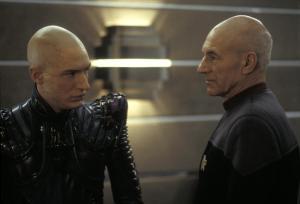
Young Tom Hardy along with Patrick Stewart
- Movie: Star Trek Nemesis (2002)
- Drop: 76%
- # of Theaters: 2,711
- Legacy: Suddenly, Star Trek Insurrection looked a lot better, huh? This was the end of Star Trek’s odd trend of only delivering good movies with the even-numbered ones (e.g., Wrath of Khan, Voyage Home, etc.) Nemesis ended up with just over $60m in worldwide gross, which is bad since it cost $60m to produce and who knows how much to market. It was 7 years before another Star Trek movie came along. Bye-bye, Picard & friends.
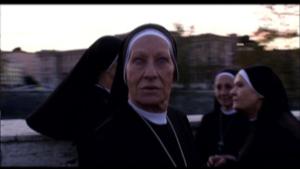
- Movie: The Devil Inside (2012)
- Drop: 76%
- # of Theaters: 2,511
- Legacy: That second weekend-drops don’t mean a damn thing when your film cost just $1m to make and you made $33m in your opening weekend. This found footage horror film ultimately grossed over $100m worldwide.
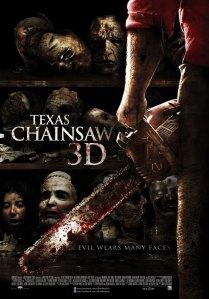
- Movie: Texas Chainsaw 3D (2013)
- Drop: 75.7%
- # of Theaters: 2,659
- Legacy: That very few even remember this is a film that happened even though it came out just two years ago, and there’s no telling how much lower its $34m domestic gross would have been without the 3D upcharge.

- Movie: The Purge (2013)
- Drop: 75.6%
- # of Theaters: 2,591
- Legacy: That second weekend-drops don’t mean a damn thing when your film cost just $3m to make and you made $34m in your opening weekend. Plus, even though your film drops off that doesn’t mean you won’t be able to recreate the same level of success with a superior sequel and marketing campaign, with last year’s Purge: Anarchy posting higher grosses domestically and worldwide.

- Movie: One Direction: This Is Us (2013)
- Drop: 74.4%
- # of Theaters: 2,735
- Legacy: That Morgan Spurlock, the Super Size Me guy, actually directed this, and that while concert films are going to be ridiculously front-loaded they can still be released in theaters and make money. One Direction ultimately ended up making $68m worldwide on a $10m production budget.
So, basically a couple of pieces of exploitation cinema performed as they usually do which is to open big before performing a magical disappearing act leaving only really Star Trek: Nemesis and Gigli as the other high-profile films to be flatly rejected once the toxic word-of-mouth spread. The difference is that unlike both Star Trek and Gigli, which carried production budgets north of $50m, 50 Shades is going to end up as one of the most profitable films of 2015, just like Fault in Our Stars last year.
This Weekend’s Actual Box Office Top 10 Totals (2/20-2/22)
1. 50 Shades of Grey 
- Production Budget=$40m
- Weekend Gross (Domestic)=$22.2m
- Weekend Gross (International)=$68.1m
- Current Domestic/International/Worldwide Total=$129.1m/$280.5m/$409.6m
50 Shades is holding up better overseas where it fell off 58% this weekend. It’s still in amazing shape, financially, but the overall decline decline can be seen as validation for all of those who say the film is dreadful. Naysayers are now extremely delighted to see that E.L. James is making a likely idiotic power grab by forcing out the director and writers so that she might pen the sequel’s screenplay on her own. The expectation is that her screenplay will be just as grammatically-challenged as her books, and that they’ll have to indulge her before hiring an actual screenwriter to re-write most of her work. As a result, a sequel won’t likely arrive until at least 2017.
2. Kingsman: The Secret Service 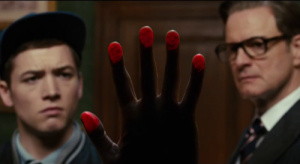
- Production Budget=$81m
- Weekend Gross (Domestic)=$18.3m
- Weekend Gross (International)=$33m
- Current Domestic/International/Worldwide Total=$67.9m/$86.4m/$154.3m
These are not really big numbers for a comic book movie, but they are for one coming outside of the Marvel/DC family and made for a modest $81m. Not all comic book movies need a minimum budget of $175m, yet the only notable mid-to-low-range budget effort on tap for the future is Ryan Reynolds’ Deadpool.
3. SpongeBob Movie
- Production Budget=$74m
- Weekend Gross (Domestic)=$16.5m
- Weekend Gross (International)=$21.9m
- Current Domestic/International/Worldwide Total=$126.2m/$76m/$202.2m
The first SpongeBob Movie (2004) topped out at $140m worldwide, which the long-delayed sequel has obviously passed.
4. McFarland, USA (Opening Weekend)
- Production Budget=$25m
- Weekend Gross (Domestic)=$11m
- Weekend Gross (International)=Nothing
- Total debut=$11m
Disney specializes in these true, inspirational sports movies, making them for very little by their standards, and throwing them out to the market for family consumption. However, regardless of the actual quality of the films there is a definite pattern of diminishing box office going on here, going from 2002’s The Rookie ($76m domestic) to last year’s Million Dollar Arm ($36m) and now to McFarland, USA. Audiences actually liked Kevin Costner’s McFarland, with an A on CinemaScore suggesting good word-of-mouth. However, with such a glut of Costner films recently, and George Lopez having his own inspirational high school teacher movie last month Disney might have been better off delaying McFarland even further (it was originally supposed to come out last November).
5. The DUFF (Opening Weekend)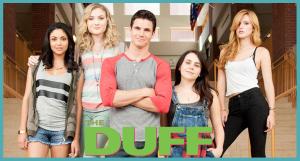
- Production Budget=$8.5m
- Weekend Gross (Domestic)=$10.8m
- Weekend Gross (International)=Nothing
- Total debut=$10.8m
Designated Ugly Fat Friend. That title alone was icky enough to turn many away from The DUFF, but like so many things with box office as of late the real target here was actually women, the younger the better. In fact, The DUFF is adapted from a novel written by a girl (Kody Keplinger) while she was still a senior in high school, giving it a ring of authenticity to the way “kids speaks these days” that not even something a prior teen film like Clueless could really claim just because its director/writer Amy Heckerling hung out with teenagers for research. So, this was a film made for and targeted at a certain demographic, which paid off with 75% of ticket buyers being female, 68% under the age of 25, 48% under the age of 18. It doesn’t hurt that despite what you might guess from the premise the film’s actually surprisingly charming with great performances from Mae Whitman and Robbie Amell.
6. American Sniper
- Production Budget=$60m
- Weekend Gross (Domestic)=$10m
- Weekend Gross (International)=$20.5m
- Current Domestic/International/Worldwide Total=$320m/$109.6m/$429.6m
7. Hot Tub Time Machine 2 (Opening Weekend)

- Production Budget=$14m
- Weekend Gross (Domestic)=$5.9m
- Weekend Gross (International)=Nothing
- Total debut=$5.9m
Wow. I actually assumed this was another Horrible Bosses 2 situation where you couldn’t really blame them for making a sequel after the first one made so much money. That’s not true in this case. The first Hot Tub Time Machine only made $50m domestic/$64.5m worldwide on a $36m budget. That just screams “Needed home video to turn a profit.” Why did they make a sequel? Apparently, everyone wondered the same thing, especially after John Cusack opted out, replaced by Adam Scott. That being said, as a fan of the dumb comedy charms of the original I fully intend to see the sequel. Just not in theaters. Redbox, baby.
8. Jupiter Ascending
- Production Budget=$176m
- Weekend Gross (Domestic)=$3.8m
- Weekend Gross (International)=$8.9m
- Current Domestic/International/Worldwide Total=$39.6m/$75m/$114.6m
9. The Imitation Game
- Production Budget=They’re not telling
- Weekend Gross (Domestic)=$2.5m
- Weekend Gross (International)=$6.7m
- Current Domestic/International/Worldwide Total=$83.8m/$76.9m/$160.8m
10. Paddington
- Production Budget=$55m
- Weekend Gross (Domestic)=$2.4m
- Weekend Gross (International)=$1m
- Current Domestic/International/Worldwide Total=$67.8m/$154.2/$222m
What Left the Top 10?: The Seventh Son (Current total: $16m domestic/$95m budget), The Wedding Ringer (Current total: $61.9m domestic/$23m budget) & Project Almanac (Current total: $21.4m domestic/$12m budget)
What’s Up Next?: Focus (Will Smith and Margot Robbie’s sexy con-artist comedy) & The Lazarus Effect (Flatliners for a new generation and as produced by Jason Blum, starring Olivia Wilde, Mar Duplass, Evan Peters, and Donald Glover)

